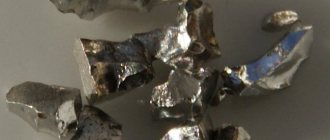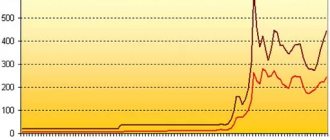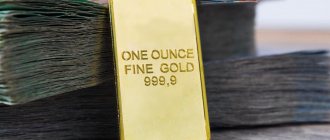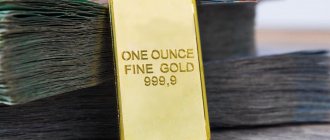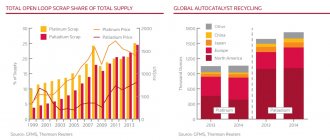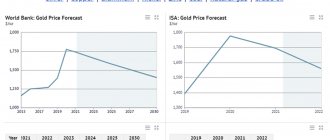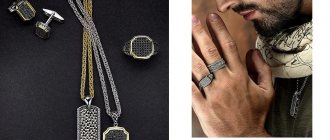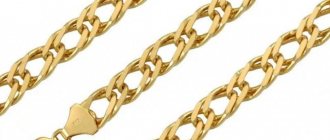Let's get acquainted with iridium. Iridium is a precious platinum metal. The crystal has a white-gold color, high strength and poor flexibility in processing. It is one of the most expensive, but costs less than gold, platinum and osmium. All people who earn more than 20 thousand rubles can buy iridium. per month. However, it is important even for them to know what weight category of jewelry they can afford. Iridium price per 1 gram in rubles - let's find out!
The price of iridium for 2021 in comparison with other metals is presented in this table:
| Precious metal, name | Cost per 1 gram in rubles |
| Gold | 2300 rub./g. |
| Silver | 34 rub./g. |
| Platinum | 1720 rub./g. |
| Osmium | 728 rub./g. |
| Ruthenium | 120 rub./g. |
| Iridium | 1719 rub./g. |
| Palladium | 1420 rub./g. |
| Rhodium | 1710 rub./g. |
These price indicators were compiled for May 2021, however, on any given day the price of iridium varies from 0.01 to 1 ruble.
Having found out the cost of iridium per 1 gram, many will decide: “Why buy an unknown metal that is not very popular if there is gold and silver?”
For some, this approach will be correct, but for people who are looking for something new, seek knowledge and love everything interesting, they should take a closer look at iridium. The information below will help with this.
What is
Iridium is a silvery-white shiny metal, a platinum group.
Element of the periodic table number 77, international name – Iridium (Ir).
Very hard (6.5 Mohs), refractory, dense. Resistant to corrosion even at extreme temperatures.
Iridium is one of the two hardest and rarest metals. Its content in the earth's crust is 10 times less than platinum, 40 times less than gold. By weight, this is one millionth of a percent.
He is considered noble by jewelers and financiers.
Iridium. Description and properties of iridium
Iridium metal precipitates after platinum is dissolved in sulfuric acid. After the reaction, the metal turns black. However, its name is translated as “rainbow”. The fact is that iridium salts are a storehouse of paints. Compounds with chlorine are brown; with fluorine – yellow; with bromine - blue. So the element received the name of the Greek goddess Iris, and she, as you know, commanded the rainbow.
Discovered by the metal chameleon Smithson Tennat. An Englishman did this in 1804. From the fact that a precipitate of iridium remains after the reaction of platinum with concentrated acid, it follows that the rainbow element is practically invincible. Only sodium peroxide and molten alkali dissolve it.
Not only are the properties of iridium , it itself is also rare. Geologists suggest that there is only one ten-billionth part of it in the bowels of the Earth. One ounce, which is only about 30 grams, costs more, thousands of dollars. The source of iridium is not only platinum, but also copper-nickel ores. True, the content of rare metal in them is negligible.
Scientists explain such a low concentration of iridium in the earth's crust by its extraterrestrial origin. It is believed that iridium was brought by meteorites and asteroids that fell on the planet throughout its existence. Otherwise, experts note, heavy metals (which include iridium) should not be in the earth’s crust at all. When the planet formed, all the heavy elements settled in the core. It is under such pressure that no forces can throw even a gram of the center of the Earth onto its surface. The conclusion, scientists note, suggests itself. Moreover, the presence of iridium in meteorites is a recorded fact.
Based on the layers of the earth's crust in which the concentration of rainbow metal is high, geologists even draw conclusions about the strength of the “cosmic attack” on the Earth at one time or another during its existence. Iridium is cosmic, but needed for completely earthly affairs. For example, molds for growing crystals are made from it. In such tanks you can get any stone, because the element, as mentioned, does not enter into 99% of chemical reactions. That is, iridium forms are completely “indifferent” to the solutions placed in them.
The production of technology cannot do without an element. Electrical contacts are made from an alloy of iridium and platinum. By the way, fuel tanks for spaceships are also made of an alloy based on the rainbow element. In cars, iridium is used in spark plugs.
Rare metal electrodes have also found application in medicine. Doctors have found that if you implant electrodes into a person’s brain, they can cure him of a whole list of diseases. The main thing is to correctly calculate the frequency of the signal supplied to the elements. Parkinson's disease is treated with a 25 Hz electrical signal. High frequency relieves symptoms of schizophrenia and epilepsy.
radioactive iridium is well known . Isotopes of the element are used in irradiating cancer patients to stop tissue growth. Most often, a rare metal is placed in an ampoule and implanted into the “body” of the tumor.
Iridium is used to make eye prostheses, and the metal is added to hearing aids. Iridium coatings save other metals from corrosion. The metal is not susceptible to it even at a temperature of 2 thousand degrees Celsius. But, it is necessary to apply the protective layer electrolytically. Otherwise, the protective layer will not adhere to the base.
If you know that fountain pens and ballpoint pens also use iridium, it becomes clear why some writing instruments cost so much. Their price is added not only by well-known manufacturing companies, but also by rare element balls at the ends of pens or ink refills.
Some surgical instruments are made from an alloy of iridium and platinum. They cannot be demolished, just like jewelry “born” from the tandem of platinum and rainbow metal. Element No. 77 (this is its position in the periodic table) is added to platinum jewelry because without iridium it is too soft and does not hold its shape. A ring or earring made of pure platinum will crumple even with light pressure.
True, products containing iridium are expensive. Not only because the bluish-silver metal has already been classified as precious, but also because it melts at a temperature of several thousand degrees. That is, to obtain an alloy of iridium with anything. You need special and very expensive equipment. So it turns out that for a small iridium ring without any stones they ask for an average of about 3 thousand dollars.
Suppliers of metal No. 77 to the world market are: - Canada, Russia, South Africa. The depths of the latter country contain the most iridium, as well as platinum and gold deposits. With total iridium reserves of 15 thousand tons, 10 thousand of them are hidden in the lands of South Africa. Thus, in 2009, global production of rare metals decreased by 13%. This is because due to internal problems, the element began to be mined less in the Republic of South Africa. There was a shortage of iridium, and its prices jumped. So, although South Africa is a developing country, other states cannot develop without it.
Among enterprises, Lonmin is recognized as the leader in iridium production. It produces a third of the global volumes of this metal on the market. He remains hopeful that meteorites will continue to fall to the ground, so as not to harm people. Otherwise, they will be harmed by the depletion of reserves of not only rare, but also extremely necessary metal for humanity.
History of discovery
The history of the discovery of iridium is associated with the name of the British chemist Smithson Tennant. While examining platinum ore from the mines of South America (1803), he tried to isolate pure metal. By treating the ore with aqua regia, an insoluble residue was obtained. Substances unknown to science were discovered here. These were iridium and osmium.
The name came naturally. Tennant was impressed by the iridescence of the salts of the new metal, and he named it iridium.
Iris was the name of the ancient Greek goddess of the rainbow.
The scientist was elected a member of the Royal Society of London, and in 1804, for the discovery of osmium and iridium, he was awarded the Copley Medal, the society's highest award.
Which precious metal is better to invest in?
When an investor wants to invest money in precious metals conveniently and profitably, he has to discard the rare and difficult to sell rhodium, ruthenium, iridium and osmium. That leaves what I call the “big four”: gold, silver, platinum and palladium. To figure out which metal is better to invest in, first let’s compare their returns over a long period of time:
palladium immediately catches your eye . This metal has significantly pulled away from gold and the rest over the past few years. The high yield of palladium is its big plus, but pay attention to 2000 - palladium reached the 1700% yield mark and fell sharply, by 80%. The risks of investing in this metal are high, despite the fact that in the current realities it is a scarce metal that is in great demand in the automotive industry.
Gold was in second place, its chart is much calmer than that of palladium, the biggest price collapse happened in 1980 - then all precious metals suffered. In 2013, after the end of ten years of growth, the drawdown in profitability was 35%. It is in gold that countries prefer to keep their financial reserves, this says a lot.
In third place is platinum . This is not visible on the chart, but it has long been the most expensive precious metal. That all changed in 2015, when demand for platinum began to fall due to a scandal with diesel car manufacturers. In addition, due to stricter environmental requirements, platinum has been replaced by cheaper and more efficient palladium. In general, the platinum market is going through hard times, although there are prospects - palladium has become too expensive, and in some industries it can be easily replaced by platinum.
The precious metal with the worst result is silver . Despite this, silver loves to follow gold and works well as a substitute for it - the charts correlate by 90%. However, when markets are doing well and precious metals are in a bearish trend, silver falls much more than gold. In some ways, this is even a plus, because silver can provide higher returns in any direction of the trend. Bottom line, silver is not a great long-term investment, but buying/selling it at the right time can be much more profitable.
We looked at the potential profitability of four precious metals, but to complete the picture we need to compare investment risk indicators:
In all respects except profitability, gold confidently wins. Palladium and silver are the riskiest, but palladium is 3 times more profitable. Perhaps it is worth taking into account the differences in the structure of demand: silver is half an investment metal, palladium is completely industrial - the cycles of rising and falling prices do not coincide. Platinum's performance is average compared to other precious metals.
Obviously, gold is the best choice for long-term investment in precious metals. However, a combination of several metals can also be effective, but not all are successfully combined in an investment portfolio.
Related article: Examples of investment portfolios using precious metals
For example, gold and silver in a portfolio will behave the same due to high correlation, this will only increase risks. The best companion for gold is platinum or palladium, as they have high industrial demand and will rise for other reasons.
Well, we have figured out the features of four precious metals, now we can move on to specifics - which metal is more profitable to invest in right now and why.
Physico-chemical characteristics
Iridium looks like any metal in the platinum family. More resistant to corrosion than gold and platinum, up to 100°C inert to acids and acidic combinations.
| Properties of the atom | |
| Name, symbol, number | Iridium / Iridium (Ir), 77 |
| Atomic mass (molar mass) | 192.217(3) a. e.m. (g/mol) |
| Electronic configuration | [Xe] 4f14 5d7 6s2 |
| Atomic radius | 136 pm |
| Chemical properties | |
| Covalent radius | 127 pm |
| Ion radius | (+4e) 68 pm |
| Electronegativity | 2.20 (Pauling scale) |
| Electrode potential | Ir←Ir3+ 1.00 V |
| Oxidation states | 9, 7, 8, 6, 4, 3, 2, 1, 0, −1, −3 |
| Ionization energy (first electron) | 868.1 (9.00) kJ/mol (eV) |
| Thermodynamic properties of a simple substance | |
| Density (at normal conditions) | 22.65/22.56±0.01 g/cm³ |
| Melting temperature | 2739 K (2466 °C, 4471 °F) |
| Boiling temperature | 4701 K (4428 °C, 8002 °F) |
| Ud. heat of fusion | 26.0 kJ/mol |
| Ud. heat of vaporization | 610 kJ/mol |
| Molar heat capacity | 25.1 J/(K mol) |
| Molar volume | 8.54 cm³/mol |
| Crystal lattice of a simple substance | |
| Lattice structure | cubic face-centered |
| Lattice parameters | 3.840 Å |
| Debye temperature | 430.00 K |
| Other characteristics | |
| Thermal conductivity | (300 K) 147 W/(m K) |
| CAS number | 7439-88-5 |
Not toxic, but hexavalent fluoride is poisonous. This disadvantage is taken into account at enterprises that use iridium raw materials.
How to invest in precious metals
Bullions of precious metals
Probably the first thing that comes to mind when choosing a way to invest in precious metals. Alas, in practice this method is the most expensive - even before you start investing, you will lose 10-30% of the value of the bullion due to the spread (the difference between the purchase and sale prices):
| Bank | A country | Gold (100g) | Silver (1000g) | Platinum (100g) | Palladium (100g) |
| Sberbank | Russia | 32% | 31% | 32% | — |
| Privatbank | Ukraine | 9% | 44% | — | — |
| BSB Bank | Belarus | 6% | 21% | — | — |
Pros and cons of investing in bullion:
✅ you can buy through a bank and sell there; ✅ you can feel the metal with your hands; ✅ fineness 999, the price of the bullion depends entirely on the exchange; ❌ VAT applies (they plan to cancel it in 2022); ❌ unpleasant spread - up to 30% due to VAT; ❌ if damaged, the price of the ingot will decrease; ❌ storing at home is risky, in a bank cell it’s not cheap.
Investment coins
Buying investment coins is an interesting idea, especially for residents of Russia due to the lack of VAT. Almost always, coins made of precious metals are more expensive than the metal in them, since there is a markup for minting and design. This markup can be very high if the coin is issued in limited edition for some event.
The pros and cons of investing in coins are the same as investing in bullion, with the exception of:
✅ VAT does not apply to coins; ❌ to make a good purchase you need to understand coins; ❌ not all coins can be sold back at the place of purchase.
Just like in bullion, the spread in coins is quite large:
But 18% is still better than 30%+ in bullion, so coins look like a more interesting way for Russian investors to invest in precious metals. As you can see, the spread is the lowest in popular gold coins, a few silver ones can also be used. You can buy platinum and palladium coins, but the bank does not buy them back, so there will be problems with the realization of accumulated profits.
Anonymized metal account
Compulsory medical insurance is a special type of bank account, the currency of which is not rubles or dollars, but one of the precious metals. On such an account, transactions are carried out with metals without any distinctive features - sample, manufacturer, serial numbers, etc. In other words, this is the purchase of precious metals at a bank without the need to receive them in person, and the cost of the deposit depends on exchange prices.
Pros and cons of an impersonal metal account:
✅ VAT does not apply; ✅ no need to look for storage space; ❌ does not participate in the deposit guarantee program; ❌ some banks have a high spread of up to 10%.
The compulsory medical insurance service is offered only by Russian banks or their subsidiaries in other countries. Since investing in precious metals is a long-term endeavor, it is worth collaborating with the largest and most reliable ones. Spread conditions:
| Bank | Gold | Silver | Platinum | Palladium |
| Alfa Bank | 2% | 3% | 2.5% | 1.5% |
| Gazprombank | 4% | 6% | 8% | 8% |
| Rosselkhozbank | 6% | 9% | 18% | 18% |
| Sberbank | 9% | 7% | 9% | 9% |
Shares of mining companies
Prices for precious metals can be too volatile, but the business that mines them tries to make a profit in any conditions. For this reason, shares of mining companies should be considered first.
Pros and cons of investing in precious metals through stocks:
✅ dividends are the only way to receive regular passive income from precious metals; ✅ business diversification - many companies mine several metals at once and suffer less from price changes; ✅ stock market brokers are more reliable (licenses, registration not in offshore companies); ❌ there is often a lag in the profitability of metals; ❌ optimal deposit from $1000.
The largest foreign mining companies:
- GOLD – Barrick Gold (gold, copper)
- NEM - Newmont (gold, silver, copper, zinc, lead)
- AU - AngloGold Ashanti (gold)
- FRES – Fresnillo (gold, silver)
- GLEN - Glencore (gold, silver, minerals, oil, gas)
- PAAS - Pan American Silver (gold, silver, copper, zinc, lead)
- AGL - Anglo Platinum (gold, copper, nickel, platinum, palladium)
- IMP - Impala Platinum (gold, copper, nickel, platinum, palladium)
The largest Russian mining companies:
- PLZL – Polyus OJSC (gold)
- POLY - Polymetal (gold, silver, copper, platinum, palladium)
- GMKN - Norilsk Nickel (platinum, palladium, nickel, cobalt)
How to buy shares: foreign through Interactive Brokers, Russian through any licensed broker.
Metal ETFs
ETFs (Exchange Traded Funds) are investment funds that can be invested in through a stock exchange. Some ETFs invest in precious metals and essentially give you the opportunity to invest directly in them without having to purchase the metal itself. Some ETFs specialize in mining companies. For participation, the investor is charged a fund commission (hereinafter referred to as CF).
Pros and cons of investing in precious metals through ETFs:
✅ the opportunity to buy metal directly on the exchange; ✅ stock market brokers are more reliable (licenses, registration not in offshore companies); ✅ convenient prices for diversification - ETFs rarely cost more than $100; ❌ optimal deposit from $1000; ❌ there are no dividends (except for ETFs of mining companies).
List of metal ETFs:
- GLD - SPDR Gold Trust (gold), CF 0.4%
- IAU - Ishares Gold Trust (gold), CF 0.25%
- SLV – Ishares Silver Trust (silver), CF 0.5%
- DGP - DB Gold Double Long (gold x2), CF 0.95%
- FXGD - Finex Gold ETF (gold in rubles), CF is included in the price.
- AGQ - ProShares Ultra Silver (silver x2), CF 0.95%
- SIVR - Aberdeen Silver Trust (silver), CF 0.3%
- PALL - Aberdeen Palladium Trust (palladium), CF 0.6%
- PPLT - Aberdeen Platinum Trust (platinum), CF 0.6%
Mining ETFs:
- GDX - VanEck Vectors Gold Miners (gold miners), CF 0.5% + dividends
- SIL - Global X Silver Miners (silver miners), CF 0.66% + dividends
How to invest in ETFs: foreign ones through Interactive Brokers, Russian ones through any licensed broker.
Trading on the Forex Market
The foreign exchange market is the most convenient way to invest in precious metals. In the trading terminal of a Forex broker, gold and silver can be found under the names XAUUSD and XAGUSD, respectively (platinum and palladium, alas, are not traded). The main cost item for a long-term transaction is swaps, which are accrued daily.
Best broker conditions for swaps (gold):
| Broker | Swap XAUUSD* | Swap per year** | Cent account |
| Forex4you | -8.08 | 29$ (~1.7%) | available |
| FxOpen | -8.92 | 33$ (~1.8%) | available |
| ICE-FX | -11.8 | 43$ (~2.4%) | not available |
*in double digit points, for long positions **for a 0.01 lot, a trade of this size is the same as buying 1 ounce of gold.
The formula for calculating the deposit for a transaction similar to buying real gold (risk coefficient = 1):
The best conditions of swap brokers (silver):
| Broker | Swap XAGUSD* | Swap per year** | Cent account |
| Alpari | -0.080 | 14.60$ (~1%) | available |
| ICE-FX | -0.084 | 15.33$ (~1.1%) | not available |
*in double digit points, for long positions **for a 0.01 lot, a trade of this size is the same as purchasing 50 ounces of silver.
The formula for calculating the deposit for a transaction similar to buying real silver (risk factor = 1):
Pros and cons of trading precious metals on Forex:
✅ minimum requirements when opening an account; ✅ deposit/withdrawal of funds to electronic wallets, some brokers accept bitcoins; ✅ many brokers have cent accounts where you can invest from $10; ✅ flexible risk management options - you can buy gold x1, x2, at least x10 (profitability increases accordingly); ❌ margin trading requires some experience; ❌ returning money in case of bankruptcy of a broker is a difficult task if he is registered offshore (an unlikely scenario, but possible).
Metal in nature
Pure iridium does not occur in nature. Almost always this is a combination with osmium, which is why professionals use the terms “osmic iridium” and “osmiridium alloys”.
There are indigenous deposits of osmic iridium in several regions of the planet: Russia, Canada, USA, South Africa, Papua New Guinea.
Other satellites of the iridium metal in the ore are rhodium and ruthenium.
At mining sites, a closed (mine) method is used.
The total global volume of metal production per year is three to ten tons.
Scientists believe that the origin of the metal is such that the main deposits need to be looked deeper:
- Earth's core. The metal was carried there by iron during the formation of the planet.
- Meteorites.
- Dinosaur bones. They are saturated with iridium, which indirectly confirms the hypothesis that animals died due to a meteorite that crashed into the Earth 65 million years ago.
Spectroscopic analysis has revealed traces of iridium in the solar corona.
There are natural isotopes of the metal. A dozen analogs with a short half-life have been synthesized. The most popular is number 192 (74 days).
Extraction and processing
The main volumes of iridium are extracted from sulfate ferrous and nickel ores. Mineralogical exotics provide a little - nevyanskite, urosmiride, sysertskite.
Pure iridium is obtained industrially from the products of processing copper-nickel alloys.
The technology is multi-stage - isolation of platinum group metals from the concentrate, leaching of the residue with water, distillation, exposure to aqua regia. Sedimentary iridium is calcined to obtain pure metal.
There are other methods: ion exchange, extraction. All production technologies are complex and costly.
In Russia, iridium is mined by enterprises in Krasnoyarsk, Yekaterinburg, and Norilsk Nickel.
Areas of application
Pure iridium is not used: it is too expensive and hard. But alloys with it are in demand from science and high technology to jewelry.
Industry
The properties of the metal determined the areas of application in the industrial complex:
- Iridium is used to make dishes, equipment, and catalysts for chemical enterprises.
- Single crystals are grown in iridium crucibles.
- In the automotive industry, this is the material of the electrodes (with copper and platinum) of spark plugs. They last longer and are used for luxury cars.
- Iridium-ruthenium alloys contain electric generators and thermocouples for measuring temperatures up to 2000°C.
- This is an indicator of the quality of welds made of steel and aluminum alloys.
The kilogram and meter standards are made from a platinum-iridium alloy (located in Paris).
The third millennium opened up space prospects:
- American Elements has created a technology for casting seamless iridium rings for use on satellites and spacecraft (2006).
- Metal is present in the displays of computers, televisions, iPhones, and other gadgets based on organic light-emitting diodes (OLED technology).
The nuclear isomer of iridium-192 with a “lifetime” of more than 240 years is considered as an energy source.
Medicine
Surgical instruments and parts of pacemakers are made from an alloy of platinum and iridium.
This is the basis for the development of nuclear medicine. Radionuclide raw materials are produced in nuclear reactors and cyclotrons. 90% goes for export.
Russia is one of the world's top five producers of raw medical isotopes.
Iridium-192 is used in flaw detection and oncologists (gamma knife).
Jewelry
Jewelers value the metal for its strength, using it in an alloy with platinum.
The American company Smithson Tennant was the first to launch the production of iridium jewelry. Iridium wedding rings are positioned by her as eternal in the literal sense: even concentrated acid and time are powerless. They do not require special care or storage conditions.
Jewelry made from alloys with the addition of iridium still looks like it was just purchased after decades.
Jewelry with iridium (even wedding rings) does not wear out and always looks like new. This advantage is especially important for products that experience increased loads (wedding rings, rings, bracelets).
Other areas
Iridium is revered by geologists and paleontologists: it is a marker of the age of layers of the earth's crust and extinct organisms.
The only coin in the world - iridium fineness 999 - was issued in 2013 by the National Bank of Rwanda (a state in eastern Africa). The denomination was 10 local francs.
Until the 1980s, iridium alloy balls were found in the nibs of luxury fountain pens, including the legendary Parker 51. It is an attribute of the elite and an accessory for the luxury fan of James Bond.
How much does an element from different deposits cost?
- The most expensive specimens are found in meteorites (they are considered museum exhibits - the price starts from 5,000 rubles per 1 gram).
- Iridium crystals separated from platinum have an average price (3,000 rubles).
- Metal bases found in folded rocks of the mountains of Russia, in peretonite rocks of Canada, South Africa, etc. (950-1900) are of low cost.
The cost depends not only on the deposit, but also on the number of its deposits in the world.
Also, the price of iridium is affected by the long and complex process of purification from impurities and residues of other metals on its surface.
